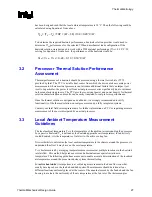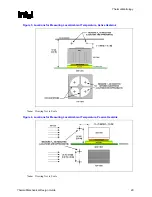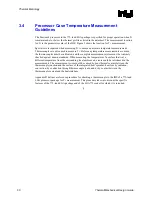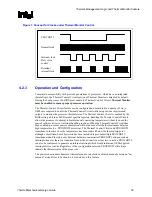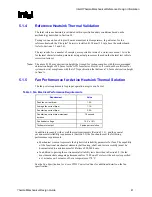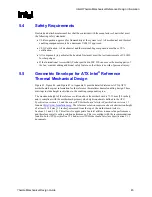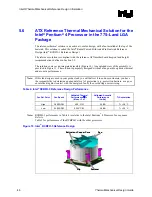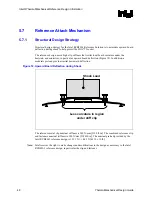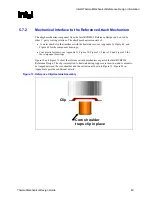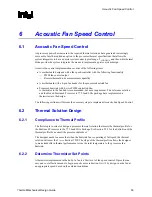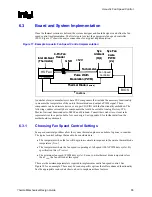
Intel® Thermal/Mechanical Reference Design Information
R
40
Thermal/Mechanical Design Guide
5.1.2 Acoustics
To optimize acoustic emission by the fan heatsink assembly the reference design implements a
variable speed fan. A variable speed fan allows higher thermal performance at higher fan inlet
temperatures (T
A
) and lower thermal performance with improved acoustics at lower fan inlet
temperatures. The required fan speed necessary to meet thermal specifications can be controlled
by the fan inlet temperature and should comply with requirements below:
1.
Thermistor set points for fan speed in the reference thermal solution
•
High set point: T
A
= 38 °C;
Ψ
CA
= 0.29 °C/W
•
Low set point: T
A
= 30 °C;
Ψ
CA
= 0.37 °C/W
The example above uses settings for the Pentium 4 processor 5xx sequence, but would be
similar for the Pentium 4 processor 6xx sequence or Pentium 4 processor Extreme Edition.
2.
Fan heatsink assembly acoustic performance:
•
Acoustic performance is defined in terms of declared sound power (LwAd) as defined in ISO
9296 standard, and measured according to ISO 7779.
•
LwAd should not exceed 5.7 BA at the high set point temperature.
•
LwAd should not exceed 4.5 BA at the low set point temperature.
While the fan hub thermistor helps optimize acoustics at high processor workloads by adapting
the maximum fan speed to support the processor thermal profile, additional acoustic
improvements can be achieved at lower processor workload by using the T
CONTROL
specifications
described in Section 2.2.3. Intel’s recommendation is to use the
Fan Specification for 4 Wire
PWM Controlled Fans
to implement fan speed control capability based on-die thermal diode
temperature. Refer to Chapter 6 for further details.
Note:
Heatsinks providing omni-directional airflow may have to provide cooling to other components
on the board, like voltage regulator and MCH. This may impact the lowest speed at which the fan
may run, and thus impact fan low set point, usually raising the minimum fan speed based on
processor thermal specification compliance only. In any case, complying with processor thermal
profile must be met at all time.
5.1.3 Altitude
The reference heatsink solution was evaluated at sea level. However, many companies design
products that must function reliably at high altitude, typically 1,500 m [5,000 ft] or more. Air-
cooled temperature calculations and measurements at sea level must be adjusted to take into
account altitude effects like variation in air density and overall heat capacity. This often leads to
some degradation in thermal solution performance compared to what is obtained at sea level, with
lower fan performance and higher surface temperatures. The system designer needs to account for
altitude effects in the overall system thermal design to make sure that the T
C
requirement for the
processor is met at the targeted altitude.
Summary of Contents for 640 - Pentium 4 640 3.2GHz 800MHz 2MB Socket 775 CPU
Page 14: ...Introduction R 14 Thermal Mechanical Design Guide ...
Page 38: ...Thermal Management Logic and Thermal Monitor Feature R 38 Thermal Mechanical Design Guide ...
Page 52: ...Intel Thermal Mechanical Reference Design Information R 52 Thermal Mechanical Design Guide ...
Page 60: ...Acoustic Fan Speed Control R 60 Thermal Mechanical Design Guide ...
Page 72: ...Heatsink Clip Load Metrology R 72 Thermal Mechanical Design Guide ...
Page 99: ...Mechanical Drawings R Thermal Mechanical Design Guide 99 Figure 50 Reference Fastener Sheet 1 ...
Page 103: ...Mechanical Drawings R Thermal Mechanical Design Guide 103 Figure 54 Clip Heatsink Assembly ...


